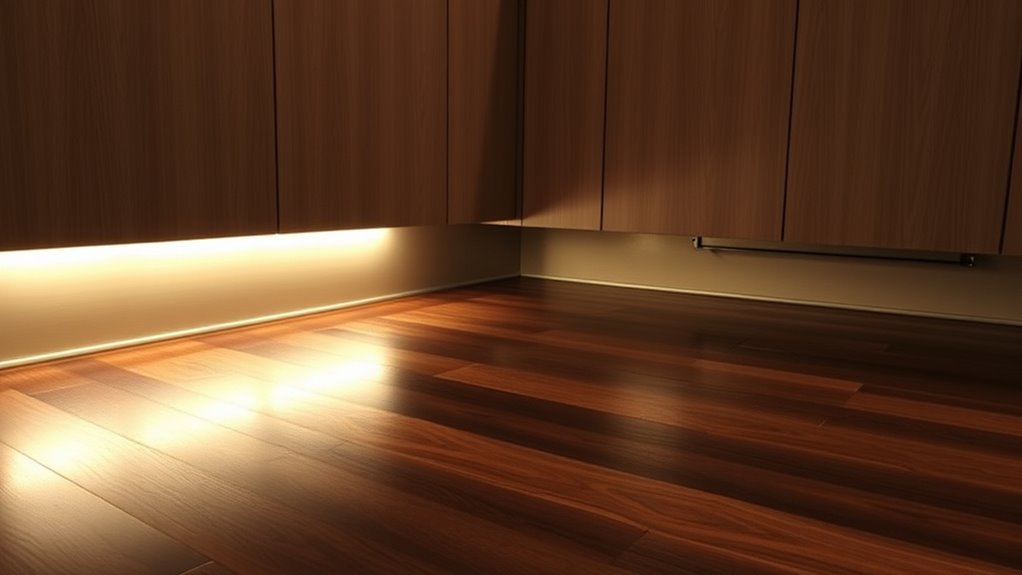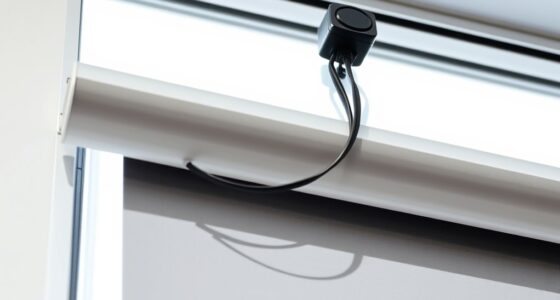To add a motion-sensing toe-kick light, start by selecting an appropriate LED strip or fixture designed for low-height installation. Mount it just under your cabinets or toe-kick area, facing downward and slightly outward to avoid glare. Connect it to a motion sensor, then calibrate the sensor sensitivity following manufacturer instructions to prevent false triggers. Proper placement guarantees effective lighting and safety. Keep exploring for detailed tips to optimize your setup for convenience and energy efficiency.
Key Takeaways
- Select a motion sensor compatible with LED toe-kick lighting and follow manufacturer installation instructions.
- Position the sensor at knee to ankle height, facing the toe-kick area for reliable detection.
- Install LED strips or fixtures just under the cabinet toe-kick, facing downward and outward to avoid glare.
- Calibrate the sensor sensitivity to prevent false triggers from pets or ambient light.
- Test the system thoroughly to ensure smooth activation and adjust placement or sensitivity as needed.

A motion-sensing toe-kick light is a smart addition to your home that automatically illuminates your path when you walk into a room. It’s designed to provide convenience and safety, especially during late-night trips to the kitchen or bathroom. When installing one, you need to pay attention to LED placement to guarantee the light effectively covers the desired area. Proper LED placement involves positioning the light strip or fixture at the right height and angle, so it illuminates the toe-kick area without causing glare or shadows. Ideally, you want the LEDs to be tucked just under the cabinet or toe kick, facing downward and slightly outward. This setup prevents direct glare into your eyes while providing enough light to see the floor clearly.
Once you’ve mounted the light, the next step is calibrating the sensor. Sensor calibration is vital for the device to respond accurately to your movements. Most motion-sensing toe-kick lights come with adjustable sensors that detect movement within a specific range. To calibrate, you’ll typically need to follow the manufacturer’s instructions, which often involve turning a dial or pressing a button to set the sensor’s sensitivity. Start by testing the sensor’s response from different distances, ensuring it activates reliably when you approach and deactivates once you walk away. If the sensor is too sensitive, it might turn on with minor motions or ambient light, leading to unnecessary activation. Conversely, if it’s not sensitive enough, it might not turn on when you need it. Fine-tuning this balance guarantees the light responds precisely when needed, saving energy and providing a seamless experience. Additionally, understanding how indoor air quality impacts overall comfort can help you optimize your home environment alongside smart lighting solutions.
In terms of LED placement, avoid placing lights directly in line with the sensor, as this can cause false triggers or glare. Instead, position the LEDs to cast light downward and outward, covering the toe-kick area without shining directly into your eyes. For sensor calibration, take your time to test different sensitivity levels, especially if your home has pets or other movement sources that could cause false activations. Proper calibration and smart placement of LEDs will make your toe-kick light both effective and unobtrusive, enhancing your home’s safety and convenience. Remember, each space is unique, so don’t hesitate to experiment a little until you find the perfect setup that works for you.
Frequently Asked Questions
What Are the Best Locations to Install a Toe-Kick Light?
You should install a toe-kick light along the underside of your cabinets where it provides the best cabinet illumination without causing glare. Position it near high-traffic areas like kitchen pathways for safety. This placement enhances visibility and adds ambiance while maintaining energy efficiency. Make sure it’s low enough to stay hidden but still effective in illuminating the floor, making your space safer and more stylish.
How Does Motion Sensing Work in Different Lighting Conditions?
Imagine a gentle whisper guiding your steps, even in dim settings. Motion sensing adapts seamlessly to ambient lighting, ensuring the sensor sensitivity adjusts to the surroundings, preventing false triggers. In bright conditions, it stays discreet, while in low light, it activates effortlessly as you approach. You’ll appreciate how smart technology intuitively responds, maintaining a cozy glow without needing manual switches, enhancing safety and ambiance effortlessly.
Can the Light Be Integrated With Existing Home Automation Systems?
Yes, the motion-sensing toe-kick light can be integrated with your existing home automation system. You’ll need compatible smart devices and possibly a hub or controller that supports your system’s protocols, like Zigbee or Z-Wave. Once connected, you can automate the light to turn on or off based on motion or time, enhancing your smart home setup for convenience and energy efficiency.
What Is the Typical Lifespan of a Motion-Sensing Toe-Kick Light?
The typical lifespan of a motion-sensing toe-kick light usually ranges from 25,000 to 50,000 hours, thanks to LED longevity. This means it can last several years with regular use. You’ll find that these lights have low power consumption, helping you save on energy costs over time. Proper maintenance and choosing quality LEDs can extend the lifespan further, ensuring your toe-kick light stays bright and efficient for years.
Are There Any Safety Concerns With Installing These Lights?
Yes, there are safety concerns with installing motion-sensing toe-kick lights. You should prioritize electrical safety by turning off power before installation and guarantee proper wiring. Follow installation precautions, like securing the light firmly and avoiding exposed wires, to prevent electrical hazards. If you’re unsure, consider consulting a professional electrician. Proper safety measures minimize risks and ensure your toe-kick light functions safely and effectively.
Conclusion
Adding a motion-sensing toe-kick light is a simple upgrade that boosts convenience and safety in your home. With most homeowners spending over 90% of their time indoors, ensuring well-lit, accessible spaces is essential. This energy-efficient solution activates instantly as you approach, saving you from fumbling in the dark. Plus, its sleek design blends seamlessly into any kitchen. Don’t miss out—installing a toe-kick light can make your daily routines safer and more comfortable.









